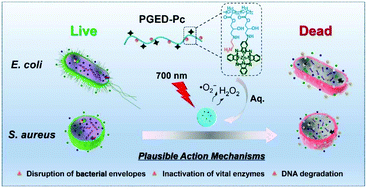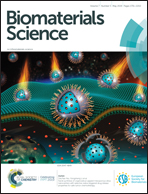Phthalocyanine functionalized poly(glycidyl methacrylate) nano-assemblies for photodynamic inactivation of bacteria†
Abstract
The design of novel antibacterial materials has attracted increasing attention for combating bacterial infections. Herein, we conjugated zinc(II) monoamino phthalocyanine (ZnMAPc) to poly(glycidyl methacrylate) (PGMA) via a ring-opening reaction, and the excess epoxy groups were scavenged by ethylenediamine (ED). The resultant macro-photosensitizer (PGED-Pc) can be easily dispersed in aqueous solution to form self-assembled nanoparticles and generate reactive oxygen species for inactivation of bacteria when exposed to light illumination. We found that the photodynamic pathway for the generation of singlet oxygen (1O2) was strongly inhibited in aqueous solution, and the major components for the inactivation of bacteria were superoxide anion radicals (˙O2−) and hydrogen peroxide (H2O2), which could result in the disruption of bacterial envelopes, the inactivation of vital enzymes, and the degradation of genomic DNA. PGED-Pc exhibited potent photodynamic antibacterial activity, with minimum bactericidal concentration (MBC, defined as 99.9% inactivation of bacteria) values of 128 μg mL−1 for Escherichia coli (E. coli) and 4 μg mL−1 for Staphylococcus aureus (S. aureus). As a proof-of-concept, the PGED-Pc nano-assemblies in aqueous solution can be readily immobilized on glass slides via a Schiff-base reaction, and impose potent photodynamic antibacterial activity upon light illumination. This work unveils a promising strategy for the engineering of self-sterilizing surfaces to combat bacterial infections.



 Please wait while we load your content...
Please wait while we load your content...